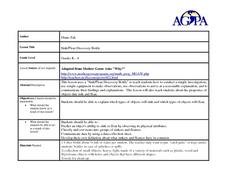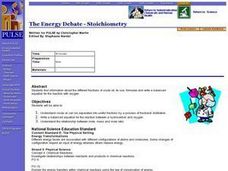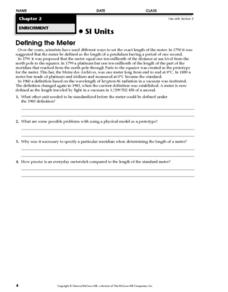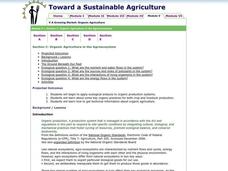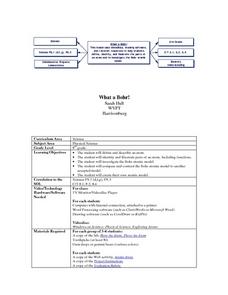Curated OER
One-digit Division
Young mathematicians read the book, The Doorbell Rang. They examine the necessity of division in everyday life, such as cooking and sharing. They use paper cookies to construct equivalent sets.
Curated OER
“Self Reliance” Questions
Is consistency foolish? Or is “foolish consistency . . . the hobgoblin of little minds”? Ralph Waldo Emerson’s “Self Reliance” provides readers with an opportunity to reflect on their own musing about being self-reliant and about...
Curated OER
Bones
Fifth graders observe real bones and models to learn about the structure and function of the skeletal system. In this skeletal system lesson, 5th graders manipulate objects and models of bones. They handle real bones and determine the...
Teach Engineering
Quantifying Refraction
Class members discover how mathematics can quantify the behavior of light waves with the fourth installment of a seven-part series that teaches future engineers about equations related to refraction, including the equation to...
Curated OER
Puberty, Day 1
Students watch a film about puberty, define key terms and compare and contrast male and female development. They discuss the purposes of brassieres, athletic supporters and mentrual hygiene products.
Curated OER
Studying Florida's Constitution: State's Rights
Students examine the basic rights in their state's constitution. They vote on a class issue, analyze how an amendment is passed, develop a flow chart to demonstrate the steps, and write and illustrate a booklet about their basic rights.
Curated OER
I Wonder Where The Manduca Came From...
Students examine how the Manduca came to America the economic means that made it possible. They discover what frass is and make observations. They make their own speculations on why the Manduca came to America.
Curated OER
Keys and Webs
Students explore and classify organisms found in a Rocky Mountain Ecosystem. Through discussions, students examine the effects upon an ecosystem if a component was removed or a new component was added. As a class, they survey reasons...
Curated OER
Module 3--Around the World
In this writing module worksheet, students fill out the opposites of eight adjectives describing towns/cities, fill in seven blanks in seven sentences with words from the word bank and write a paragraph comparing themselves to a friend...
Curated OER
Sink/Float Discovery bottle
Investigate which items float and which ones sink using this resource. Learners participate in an activity in which they investigate this phenomena. Then they describe the experimental process, and learn how to display their results.
Curated OER
Properties of Metals
Fifth graders study the properties of metals and use them to identify different properties. In this metal properties lesson students complete a demonstration .
Curated OER
Conductors and Insulators
Fifth graders explore conductors and insulators. In this science lesson, 5th graders act as electrons moving through a wire. Students break into groups representing conductors and insulators and explore how they work with electrons.
Curated OER
Latin Roots dict, duct, and vent: Crossword Puzzle
The website housing this crossword puzzle offers 8 activities to support mastery of vocabulary containing Latin roots dict, duct, and vent. No word bank is on the page with the puzzle, but the site has three levels of lists for each root...
Mr. E. Science
The Periodic Table
This science presentation focuses on the elements in the periodic table. It begins with the parts of an atom, explaining atomic mass and atomic number, valence electrons, and isotopes. Then it moves on to discuss various ways of...
Curated OER
Lesson 2 - Design Process-Measuring Wind Speed
A terrific lesson focused on the design process. It begins with a presentation, "Design: Solve a Problem," which lists the steps of the process and then introduces the specific challenge: to build a device that measures wind speed....
Curated OER
Circles
Tenth graders explore and define the radius and diameter of a circle. In this geometry lesson, 10th graders calculate the circumference and area of a circle using real world objects and shapes. They discuss chords and lines tangent...
Curated OER
Academic Raceway: Matter
This PowerPoint enables students to review concepts about the states of matter. This interactive review game provides students with an opportunity to demonstrate their knowledge of subject specific vocabulary.
Curated OER
The Energy Debate - Stoichiometry
Students determine crude oil can be separated into useful fractions by a process of fractional distillation. They write a balanced equation for the reaction between a hydrocarbon and oxygen.
Curated OER
Basics of Archaeology
Young scholars identify what and how to complete an Archaeological excavation is conducted. They identify the transition from one layer to the next more easily if the colors of the layers are different. When creating a dig, the teacher...
Curated OER
Defining the Meter
In this length worksheet, students read about the history of a meter. Students also answer 4 comprehension questions about the reading.
Curated OER
Energy and Work: Transformation through Engines
Students are introduced to the concept of thermodynamics. In groups, they participate in experiments in which they discover how potential energy converts into kinetic energy. They use the internet to research the components of a...
Curated OER
Crossing the Color Line
Students watch the series "Unforgiveable Blackness". They analyze Jack Johnson's life to investigate the legal system and interracial relationships. They examine how segregation was threatened by peole allowing to marry ones out of their...
Curated OER
Toward a Sustainable Agriculture
Students analyze organic production systems. In this organic agriculture lesson, students examine key organic practices for both crop and livestock. This lesson includes 5 different activities, 4 critical thinking questions and...
Curated OER
What a Bohr!
Students define, identify and illustrate the parts of an atom, and investigate the Bohr atomic model. Students watch a multimedia presentation to understand an atom's parts and their functions. In groups, they create a model of an atom...









